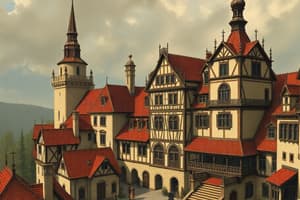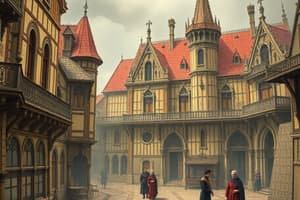Podcast
Questions and Answers
What system characterized social hierarchies during the Middle Ages?
What system characterized social hierarchies during the Middle Ages?
- Industrialism
- Mercantilism
- Feudalism (correct)
- Socialism
Which of the following factors notably influenced regional variations during the Middle Ages?
Which of the following factors notably influenced regional variations during the Middle Ages?
- Religious beliefs
- Local resources (correct)
- Trade routes
- Technological advancements
How did the Middle Ages contribute to modern societies?
How did the Middle Ages contribute to modern societies?
- By evolving social and political structures (correct)
- By promoting global unification
- By establishing democratic governments
- By eliminating class divisions
Which architectural styles are mentioned as reflections of cultural and religious values?
Which architectural styles are mentioned as reflections of cultural and religious values?
What demographic constituted a significant portion of the Middle Ages population?
What demographic constituted a significant portion of the Middle Ages population?
What was a significant outcome of the collapse of the Western Roman Empire during the Middle Ages?
What was a significant outcome of the collapse of the Western Roman Empire during the Middle Ages?
How did Christianity influence the social and cultural landscape during the Middle Ages?
How did Christianity influence the social and cultural landscape during the Middle Ages?
What economic system became prevalent during the early medieval period?
What economic system became prevalent during the early medieval period?
Which technological advancement is noted for increasing agricultural productivity during the Middle Ages?
Which technological advancement is noted for increasing agricultural productivity during the Middle Ages?
What role did the Crusades play in cultural interactions during the Middle Ages?
What role did the Crusades play in cultural interactions during the Middle Ages?
What institution began to emerge during the Middle Ages as societies required specialized knowledge?
What institution began to emerge during the Middle Ages as societies required specialized knowledge?
Which aspect of Middle Ages culture is highlighted for its unique expressions?
Which aspect of Middle Ages culture is highlighted for its unique expressions?
What key theme characterized the transition from a centralized Roman economy in the Middle Ages?
What key theme characterized the transition from a centralized Roman economy in the Middle Ages?
Flashcards
Feudalism
Feudalism
A system of reciprocal obligations between lords and vassals, defining social hierarchies in medieval Europe.
Guilds
Guilds
Organizations of skilled workers in medieval Europe, regulating crafts and trade.
Regional Variations in Medieval Europe
Regional Variations in Medieval Europe
The Middle Ages were not uniform across Europe; each region had its own unique development, influenced by factors like climate, resources, and ethnicities.
Importance of Studying the Middle Ages
Importance of Studying the Middle Ages
Signup and view all the flashcards
Medieval Transition Period
Medieval Transition Period
Signup and view all the flashcards
What is Middle History?
What is Middle History?
Signup and view all the flashcards
Political Fragmentation in the Middle Ages
Political Fragmentation in the Middle Ages
Signup and view all the flashcards
The Rise of Christianity in the Middle Ages
The Rise of Christianity in the Middle Ages
Signup and view all the flashcards
Economic Changes in the Middle Ages
Economic Changes in the Middle Ages
Signup and view all the flashcards
Technological Advancements in the Middle Ages
Technological Advancements in the Middle Ages
Signup and view all the flashcards
Cultural Exchange and Interaction in the Middle Ages
Cultural Exchange and Interaction in the Middle Ages
Signup and view all the flashcards
Development of Universities in the Middle Ages
Development of Universities in the Middle Ages
Signup and view all the flashcards
Art and Architecture in the Middle Ages
Art and Architecture in the Middle Ages
Signup and view all the flashcards
Study Notes
Overview of Middle History
- Middle history, often referred to as Medieval history, is a vast period spanning roughly from the 5th to the 15th centuries CE.
- It's a period marked by significant transitions and developments across Europe, and parts of the Middle East, North Africa, and Asia.
- It's sometimes described as the period between classical antiquity and the early modern period.
Key Themes in Middle History
- Political Fragmentation and Consolidation: The collapse of the Western Roman Empire led to political fragmentation in Europe. Early medieval societies were characterized by decentralized power structures, with kings, nobles, and local lords holding significant authority. Over time, these entities consolidated, forming larger kingdoms and empires.
- Rise of Christianity: Christianity played a dominant role in shaping social, political, and cultural life across Europe. The Catholic Church became a powerful institution, influencing laws, education, and the arts. Monasteries were important centers of learning and preservation of knowledge.
- Economic Transformations: The early medieval period experienced a shift from a centralized Roman economy to a more localized and agricultural model. Manorialism, a system of land ownership and labor obligations, became prevalent. Later, trade gradually revived, connecting different regions and fostering economic growth, culminating in the development of significant urban centers.
- Technological Advancements: The period witnessed notable advancements in agriculture, warfare, and construction. Innovative technologies like the heavy plow increased agricultural productivity. New military technologies and architectural styles also emerged.
- Cultural Exchange and Interaction: The Middle Ages saw the exchange and interaction between different cultures, including those in Europe, Asia, and Africa. This interaction played a major role in the spread of ideas, technological innovations, and religious beliefs. The Crusades, while often highlighted for conflict, also represent a complicated period of cross-cultural encounter.
- Development of Universities: As societies became more sophisticated, the need for specialized knowledge grew. Universities began to emerge as centers of learning, fostering intellectual discourse and the development of new disciplines like law, medicine, and theology.
- Art and Architecture: The Middle Ages produced unique artistic and architectural expressions. Romanesque and Gothic styles emerged, reflecting the cultural and religious values of particular societies.
- Social Structures: Feudalism, a system of reciprocal obligations between lords and vassals, defined social hierarchies for much of Europe. Guilds organized crafts people and merchants. The common people made up a large portion of the population and worked in agriculture or craft trades.
Regional Variations
- It's important to remember that the Middle Ages were not uniform across Europe. Different regions had their own trajectory of development, with varying political structures, social customs, and cultural values.
- The Byzantine Empire and Islamic Empires experienced different trajectories.
- Factors such as differing climates, local resources, and the presence of different ethnic groups influenced regional dynamics greatly.
Importance of the Middle Ages
- Understanding the Middle Ages helps to understand the foundations of many societies prevalent today. Social and political structures, cultural norms, and values all emerged or evolved from the middle ages, and the study of medieval history aids in tracing the origins of these developments.
- The medieval period laid the groundwork for the developments of the early modern and modern world.
- It represents a complex transition period between antiquity and modernity, displaying both continuity from the past and the emergence of new forms of organization, institution, and expression.
Studying That Suits You
Use AI to generate personalized quizzes and flashcards to suit your learning preferences.




